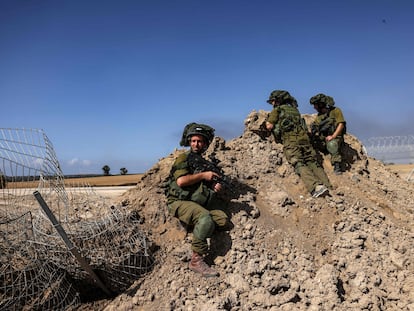Israeli troops at the gates of Gaza prepare for the invasion: ‘Of course we want to go in’
Hundreds of soldiers surrounded by tanks and armored vehicles await the order to advance and occupy the Strip by land as part of a three-phase plan announced by the Israeli Minister of Defense

At the gates of Gaza one breathes war ardor and dust. Hundreds of Israeli troop carriers, tanks, trucks, and other military infrastructure are waiting at different points around the Strip for the order to launch a ground invasion. Defense Minister Yoav Gallant on Friday presented a three-phase plan to topple Hamas, the Islamic fundamentalist militia that rules Gaza and carried out the bloody attack on Israeli soil on October 7. That strategy does not include the Israeli troops staying permanently inside Gaza once the ground operation is concluded. “Of course we want to go in,” admits Zib, a 25-year-old soldier from the town of Yaffa, near Tel Aviv. The young man stands under the barrel of one of the tanks adorned with the national flag while chatting with a group of comrades and sipping refreshments.
They are located in the vicinity of Kibbutz Beeri, just three kilometers from Gaza. This community was one of the scenes of the massacre in which some 1,400 people were killed by Hamas militants, according to Israel. Hundreds of uniformed personnel are currently carrying out maintenance work on the battle tanks or killing time with their cell phones while waiting for the country’s highest authorities to launch them as a battering ram against the enemy.
“No, it’s not about revenge,” clarifies Private Zib in response to the question of whether he will think about what Hamas did in Beeri when it is their turn to strike. “We’ve been here for two weeks,” explains another 24-year-old uniformed man who prefers not to give his name. “We will do what we are ordered to do. We are following orders,” he says dryly, unable to give any more details or make any further statements. On three occasions, the soldiers’ superiors — almost all of them very young — tried to keep them from talking to EL PAÍS. “It’s the rules. They can’t talk,” responded one of those commanders when asked why they interrupted the interview.
Israel’s Defense Minister Yoav Gallant said Friday that Israel is currently in the first phase of its strategy: “a military campaign that includes bombing and later will include [ground] maneuvers, with the goal of neutralizing terrorists and destroying Hamas infrastructure.” The second “will require lower-intensity operations, with the goal of eliminating pockets of resistance,” Gallant said. That means keeping troops on the ground to wipe out the insurgency, which has 200 hostages spread across the Strip whose lives hang in the balance in the midst of the war. Hamas released this Friday, after the mediation of Qatar and for “humanitarian” reasons, two U.S. nationals, a mother and her daughter.
The last phase would consist of the Israeli “withdrawal” from Gaza and “the establishment of a new security reality for the citizens of Israel”, the minister added, without detailing to whom the authority in that territory would be transferred once the government of the Islamic fundamentalist militia has been disbanded.
The perimeter with electrified fence surrounding Kibbutz Beeri is a constant coming and going of Israeli military vehicles and tanks. Airplanes that have been bombing the inhabitants of the Strip for two weeks — where 4,137 people have died as of Friday, according to the Gaza Ministry of Health — are buzzing through the air like blowflies. Meanwhile, in the background, over the Strip, a column of smoke rises at the height of Gaza City.
Hundreds of thousands of inhabitants remain in Gaza City despite an Israeli order to move to the southern half of the Strip, where the border with Egypt is located. There, the Rafah crossing is expected to be unblocked over the weekend, U.S. President Joe Biden said Friday. This is the point through which humanitarian aid must enter the Gaza Strip in order to deal with the humanitarian crisis that is shaking a population of more than two million people living under a permanent blockade, which became “complete” a week ago. According to the UN, more than one million people have had to leave their homes in the midst of the Israeli bombardment. Among the targets hit in the last hours was the Orthodox church of St. Porphyry, which was being used as a shelter by Gazans.
Meanwhile, inside the community of Beeri, where 100 residents out of a population of a thousand were killed, the search for bodies and human remains continues almost two weeks after the carnage. Press access to this closed military zone requires official permission. The Hamas attack on the 7th also left 200 hostages, who were transferred to Gaza, and between 100 and 200 people missing, according to data updated by Israeli authorities on Thursday. The site has now been turned into a barracks where soldiers are also stationed, waiting to advance as soon as the order to invade is given.
“It is always possible that the body of one of our own or of a terrorist will turn up,” explains Amir Golan, 73, a member of the Zaka organization, which is in charge of rescuing the bodies of Israelis. Golan helps a young man climb up to the second floor of one of the houses in Beeri that have been practically destroyed. “There could be dead bodies anywhere,” he adds, pointing to the mountains of rubble and debris.
Convoys of trucks carrying tanks, armored personnel carriers, generators, ammunition, bulldozers… The country’s top officials have traveled there in recent hours to encourage the troops. As they acknowledged Friday, some of these soldiers have been taking up positions and hoping to advance towards the perimeter of the Strip since only hours after the October 7 attack. “Now you see Gaza from a distance, soon you will see it from the inside,” Minister Gallant told them Thursday. “On to victory, ready?” Prime Minister Benjamin Netanyahu harangued them, hinting that the ground invasion could happen any time.
Sign up for our weekly newsletter to get more English-language news coverage from EL PAÍS USA Edition
Tu suscripción se está usando en otro dispositivo
¿Quieres añadir otro usuario a tu suscripción?
Si continúas leyendo en este dispositivo, no se podrá leer en el otro.
FlechaTu suscripción se está usando en otro dispositivo y solo puedes acceder a EL PAÍS desde un dispositivo a la vez.
Si quieres compartir tu cuenta, cambia tu suscripción a la modalidad Premium, así podrás añadir otro usuario. Cada uno accederá con su propia cuenta de email, lo que os permitirá personalizar vuestra experiencia en EL PAÍS.
¿Tienes una suscripción de empresa? Accede aquí para contratar más cuentas.
En el caso de no saber quién está usando tu cuenta, te recomendamos cambiar tu contraseña aquí.
Si decides continuar compartiendo tu cuenta, este mensaje se mostrará en tu dispositivo y en el de la otra persona que está usando tu cuenta de forma indefinida, afectando a tu experiencia de lectura. Puedes consultar aquí los términos y condiciones de la suscripción digital.
More information
Archived In
Últimas noticias
Welcome to the post-religion era: The idea of Christianity as the absolute truth has become obsolete
‘I thought you would like it’: The risky sexual practice popularized by TV shows and TikTok
The digitalization of tourism: ‘They promise experiences and gave us the worst possible one’
Mexican peso defies uncertainty with forecasts of a new period of stability in 2026
Most viewed
- Sinaloa Cartel war is taking its toll on Los Chapitos
- Reinhard Genzel, Nobel laureate in physics: ‘One-minute videos will never give you the truth’
- Oona Chaplin: ‘I told James Cameron that I was living in a treehouse and starting a permaculture project with a friend’
- Why the price of coffee has skyrocketed: from Brazilian plantations to specialty coffee houses
- Silver prices are going crazy: This is what’s fueling the rally










































